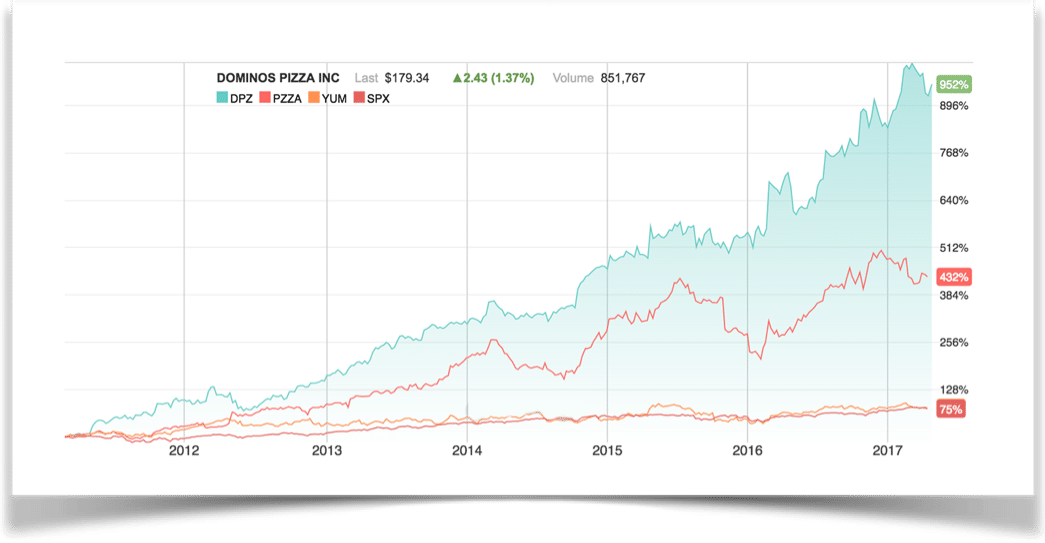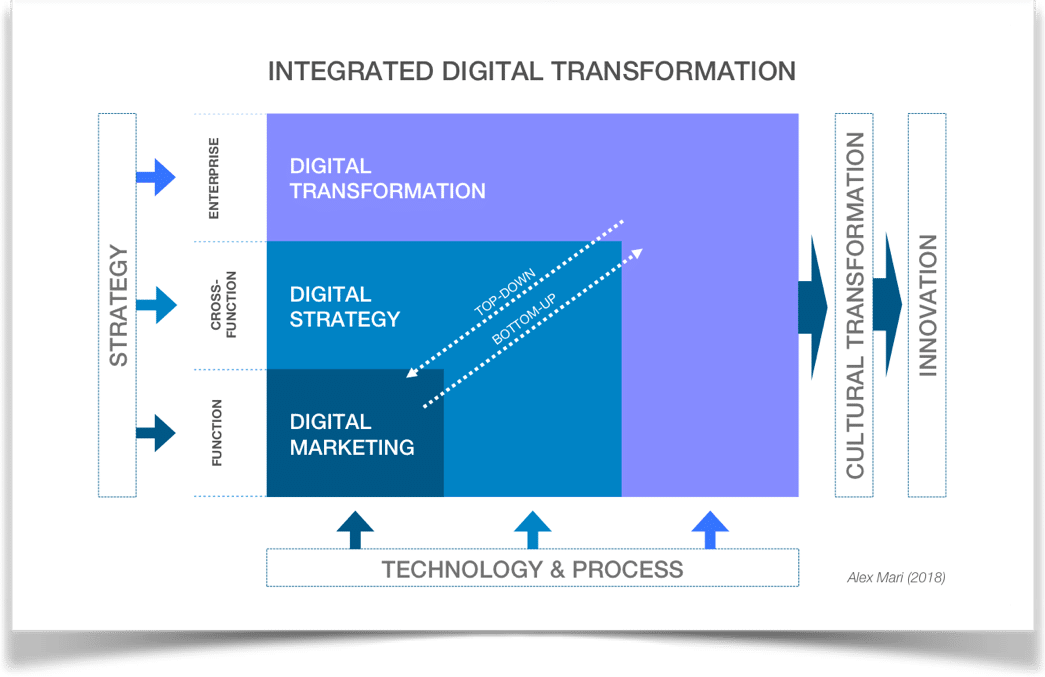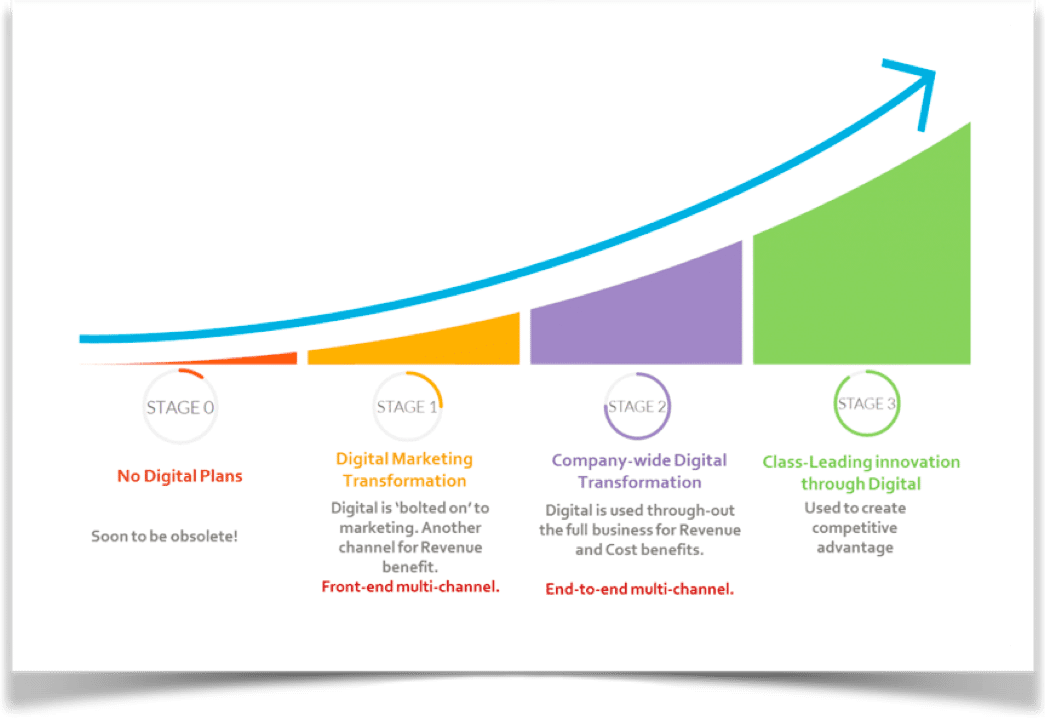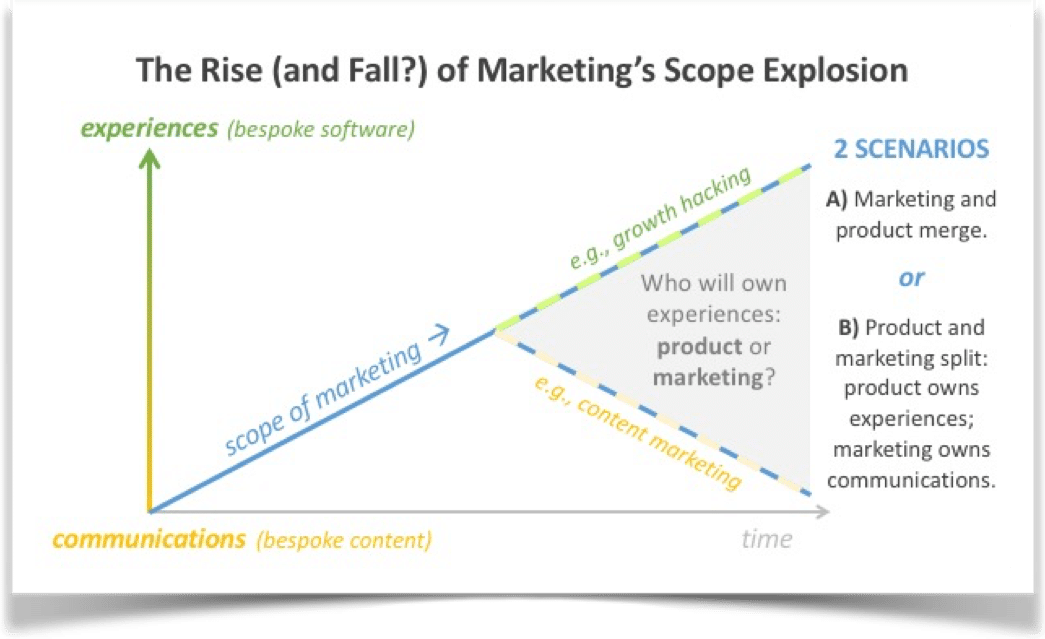The words Digital Transformation, Digital Strategy and Digital Marketing are often used interchangeably and even confused with one another given that they all seek to leverage the advancements in digital technology.
And while there are clear differences and similarities between each, the lines are often blurred, complicated by interpretations.
Let’s examine these further.
WHAT WE ALL AGREE ON
All three terms seek to leverage digital innovation and other technological advancements to meet business goals.
These include creating better interfaces, reducing costs and generally better efficiencies and human experiences all around!!
But to what degree and to what intent?
The key difference between the 3 terms lies in their scope or ambition.
Some of the best examples of this ongoing transformation ( also called disruption given the extent of the upheaval caused) can be very well explained by what is now a very popular slide by Sandy Carter (@sandy_carter)

I couldn’t find a great slide to sum up some of the most groundbreaking digital strategies so I’m just going to deep dive into one case study to clarify the concept. The “ largest pizza company in the world” Dominos based on global retail sales figures from Worry Free Labs.

Recognizing that the internet would be critical to their business as far back as 2008, Dominos was the first to introduce digital ordering which has since then developed further features like real time tracking & easy order profiles across a host of devices & platforms enhancing the complete order experience. Also on the back of their social media crisis, they launched the Pizza Turnaround campaign which further won them goodwill and loyalty.
Now while they are investing in upgrading their delivery and other processes via technology, these early wins are on account of their focusing on “ customers” as a specific target segment.
There is no earth shattering reinvention of the pizza as a product or the delivery experience…it’s simply been improved using digital technology making this a great example of Digital Strategy.
Instead of using a different example to explain Digital Marketing, let’s just go back to Dominos. While the online ordering or tracking cannot technically fall into “ digital marketing”, one of the strategies used was the use of social media to share the “Pizza Turnaround” campaign which is a great example of digital marketing.
[insert page='is-martech-secretly-killing-your-marketing' display='single-related-article-02.php']
To answer this we have to embrace the fact that most companies dabble with digital strategy rather than executive a full on digital transformation. This could be because marketing enables leveraging the biggest customer touchpoint not to mention a direct revenue impact!
The confusion between digital strategy and digital marketing may also be due to the fact that companies are increasingly offering co-adjacent digital strategies like payment gateways or chat support to install an item already purchased. Is installing software the job of marketing or sales? Or IT.
It’s hard to say.
If you see marketing and service as the stage area that customers can see and supporting functions like IT or HR as the back stage processes that help execute the performance, it becomes obvious that the goals are the same. And ultimately you need the same amount of transformation in your backstage as you want seen on-stage.
But not only are the lines between product, service and marketing increasingly blurred, companies logically start by wanting to digitalize all customer facing transactions of which marketing is a big part. But it isn’t the only one.
Let me share some popular infographics that (with some variation) explain these points really well.
(I love people who can just distill all the wisdom and wordy ideation into a few circles and boxes..they really do have exceptional clarity)
Created by Alex Mari, an AI in Marketing Researcher at University of Zurich, the image below is the easiest way to understand the difference between the 3 terms under discussion. But do note that instead of going with 3 concentric circles, he has added some new dimensions which further comment on the difference and similarities between the 3.

The next image is courtesy Richard Morecroft who is a Senior Partner, Strategy and Leadership at Digital Works Group. This to my mind helps understand the progression of digital that is common to most organizations.

This clearly shows how marketing is a common starter strategy for organizations looking to embrace digital. It is what we call the proverbial “ low hanging fruit”.
This next infographic from Compact demystifies the topic further shedding new light on why digital marketing is a minefield today, confused routinely with digital transformation.

What I understood from this is that while digital marketing is about “ attracting’ customers, starter digital strategies are “ customer focused” which means that they need to reinvent the complete product / service experience from consideration to post purchase of which marketing is just one part. This is termed “ Digital customer engagement” and while routinely confused with “ digital marketing” includes components like delivery, service and payment among others that have traditionally not been within the purview of marketing. A throwback to one of the points we discussed above.
[insert page='get-a-ringside-view-to-competitive-strategies-with-your-semrush-marketing-toolkit' display='single-related-article.php']
Now, let's take a step back here. Business functions were designed and also defined basis the logical cross leverages and goals within each. But digital channels ( and all technology) cuts across functions - they are as relevant to HR “marketing” a position to get the best talent as they are to IT “ marketing” a new platform for better information flow.
And we have to ask if it still makes sense to have a sales team, a marketing team and a recruiting team use LinkedIn individually or do we need a social media expert projecting a more cohesive brand message by managing the sales, HR and recruiting requirements for LinkedIn.
I don’t know the answer but if usage is any indicator, the lines between product, marketing, sales and service are no longer straightforward. The ultimate goal appears to be “ experience management” via the best in class solutions available and the channels WILL overlap given the complexity of fast colliding journey cycles.
[bctt tweet="Customers can be employees and vice versa and you need consistency across touchpoints. " username="relevance"]
The changing scope ( and role ) of marketing is explained beautifully in this infographic from Chief Martec.

Truth is that in the digital era, the expectations from “ digital content” go beyond just marketing. The aesthetic design of the website that indicates quality, the 360 degree product angles that facilitate exploration, the 10 field information form required to purchase as well as the chat support to help install… These are all part of the consumer journey cycle or user experience and marketing is currently the default owner!
I came across a few more terms while doing research that I wanted to include since semantics is what led us here.
Please do share your comments and any other words in circulation that relate to Digital Transformation, Digital Strategy and yes, Digital marketing.